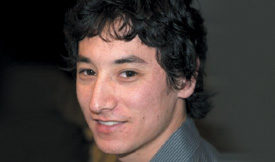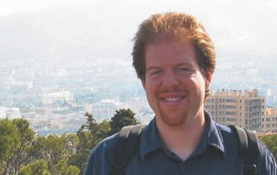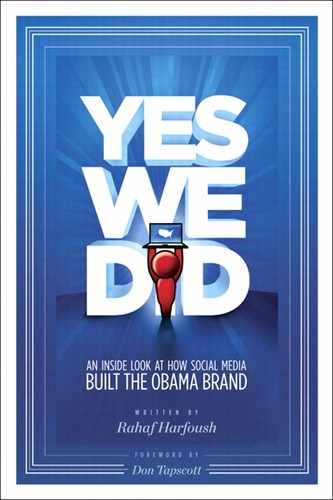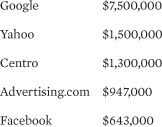13. Analytics and Online Ads
DRIVING AND MEASURING TRAFFIC
WHILE THE CAMPAIGN WAS EXPERIMENTING with new and innovative applications of social networking tools, the new media team was focused on delivering results. The online advertising and analytics departments worked tirelessly to achieve this goal. Online Ads placed banners, text ads, and display ads all over the web to drive traffic to Obama’s website. The analytics team studied everything from page views to email open rates to provide an overall snapshot of new media performance. In this chapter, we’ll look at the strategies behind driving and measuring traffic on a dynamic site like barackobama.com:
THINK LIKE THE END USER — The online ads team anticipated popular search terms and news-cycle targeted words to drive supporters to the Obama website.
THE POWER OF ITERATION — The analytics team measured new media’s initiatives and recommended ways to increase effectiveness.

Think Like the End User: The Power of Search and Targeting
The online ad team would spent $16 million on online advertising in 2008 alone, eclipsing Senator McCain’s’ expenditure of $3.6 million. To get supporters to visit the site, the online team had to think like the end user and anticipate the search terms and behavior that would lead to more site traffic. Search-based ads were the foundation of the campaign’s online ad strategy because they were so effective in recruiting new donors, volunteers, and supporters. A search-based ad is one or two lines of text that appear when a user searches for a particular word or phrase in an engine like Yahoo or Google. The ads usually appear on the search result page as “sponsored links” separate from the regular search results.
To help meet its primary goal of recruiting new Obama supporters, the team bought search-based ads tied to a mix of news-cycle targeted words (Palin, McCain, economy) and frequently searched terms (Barack, Obama, vote, Democrat). New Media Director Joe Rospars described the return on investment as nearly 15 to 1. Display ads, graphics, or banners placed on a variety of websites and blogs were used less often. These promoted specific calls to action, such as subscribing to a text-messaging campaign.
Social networks also saw their share of online ads: the Obama team purchased $643,000 worth of Facebook ads over the course of the campaign. Online ads were purchased in smaller quantity on MySpace and BlackPlanet. The campaign also invested in advertising on blogs, with $149,000 spent with blogads, the popular advertising blog network representing 1,500 of the web’s most popular blogs.
Obama was the first political candidate to advertise in video games using Microsoft’s gaming ad network, Massive. $94,000 was used to encourage early voting in popular games such as Burnout Paradise. These initiatives uncovered a wealth of untapped real estate that can be used by political candidates to engage a younger audience that might miss messages being sent through traditional mechanisms.
SPOTLIGHT

Jeff Lane,
INTERACTIVE MARKETING MANAGER, ONLINE ADVERTISING
JOINED THE CAMPAIGN: August 2008
ON HIS ROLE: I was the Interactive Marketing Manager responsible for search engine marketing and landing page optimization, part of the online advertising team in the new media department.
ON GETTING ON THE NEW MEDIA TEAM: I saw an article on a digital marketing website that mentioned the Obama campaign’s was looking for interactive marketing managers. I applied for the position, even though the job posting was a month old. A month later, Andrew Bleeker, Director of Online Ads, called me and offered me the job. I quit my current job and relocated to Chicago.
ON THE NEW MEDIA TEAM: The team is a group of young, very smart, and highly driven overachievers. There was a shared sense of optimism and a passion to win.
ON THE IMPORTANCE OF COMPUTER SECURITY: We spent a lot of time around each other, simply as a result of the campaign hours. Every day, our team took a group photo. I haven’t looked at them, but it was fun. Leaving your computer unlocked was a bad idea. The first time I did that, Gray Brooks changed my font and resolution settings so I couldn’t read anything on my screen. There was a constant stream of funny and embarrassing emails “from” people who had forgotten to lock their computer.
ON ELECTION DAY: During the day, I had mixed feelings of nervousness, excitement, and optimism, but mostly I was hungry to win (and felt fairly confident that we would). I was working until about 10:00 p.m., so I was primarily concerned with performing my job. I didn’t have time to reflect on the situation until we started walking to Grant Park.
Election night was the most memorable night of my life. Standing in Chicago’s Grant Park, surrounded by coworkers who had become friends, and my family who had flown in for the occasion, I was overwhelmed by the moment—and I knew that my experience was being shared by millions of people around the world. It felt great—like we were on top of the world.
ON OBAMA’S ADVICE: Election night was my favorite moment, for sure. Visits from Michelle Obama and Joe Biden, and the phone calls from Barack, especially when he warned us against getting arrogant and overconfident. Good advice.
JEFF’S MESSAGE: This election wasn’t just a win for Barack Obama, it was a win for the American people. It’s time for us to move forward and confront our problems with courage, conviction, and determination. We’ve done it before, we can do it again.
Analytics: The Power of Iteration
Team Analytics was the Obama campaign’s watchdog, monitoring and measuring everything from the effectiveness of online ads, to the open rates of emails. Using services like Google Analytics and Google Website Optimizer, the campaign gathered enough data to establish a solid understanding of where supporters were spending their time on the Obama site, and where and when to place the ads that would draw them there. Every email, text message, website visit, and online ad was also analyzed. Multiple variations of the same email were created to test the impact of a header, the value of embedding video versus audio, and having a donate button instead of a text link. This information was used to continuously refine the campaign’s online communication strategy. Improvements and adjustments were made daily and the results could be seen in the improved conversion rates.
The analytics team was led by Dan Siroker, who had previously headed up the development of Google’s browser, Chrome. Siroker’s job was to find quantifiable ways to maximize voter outreach and donations. This was another new development in political campaigns, as this task had traditionally been outsourced to a vendor. The Obama camp had identified enough value in the service to have a team in-house.
Having attended Obama’s speech at Google in 2007, Siroker was immediately struck by his authenticity and vision for a better America. “I called my girlfriend and brother and left them enthusiastic voicemails about how this guy was the real deal and how I had never been in love with another man as much as I was that day,” he posted on his blog. “In the back of my mind I was a bit worried that this euphoria must have been similar to the euphoria felt by the masses who were persuaded to follow the ideologies of dictators and tyrants. I told myself to take time to make sure I was making the right decision, whatever that decision might be.” Dan picked up a copy of The Audacity of Hope and became convinced that participating in the campaign was the right thing to do. “After hearing Obama speak about his ideas for how technology and innovation are going to help solve some of our country’s biggest problems, I knew I could do more than just donate money. I would rather do my best trying to make a difference than do nothing and question myself after it’s too late.”
The campaign embraced a philosophy of constant iterations by using the data they collected to instantly adjust and course correct on social media initiatives. This says a lot about the campaign’s experimentation mentality, and how organizations can adopt a similar mindset. The campaign was always learning, using every method of online outreach as an opportunity to improve their processes. While many companies are not dealing with the condensed and finite timeline of an election, there is much to be learned from constantly testing and updating processes. Building agility and flexibility into internal systems can ensure that companies evolve with the technology and adapt to changes with their consumers instead of needing a massive technological overhaul every few years. This runs contrary to many corporate philosophies that state things must be perfected and refined before being released.
“It was similar to what I felt when I witnessed Steve Jobs announce the iPhone at MacWorld.”
—Dan Siroker, Analytics Lead, after hearing Obama speak at Google in 2007
![]()
SPOTLIGHT

Jim Pugh,
TEAM ANALYTICS
JOINED THE CAMPAIGN: Summer 2008
ON HIS ROLE: I worked on the analytics team of the new media department. Our job was to work with the online data collected by the campaign and to (a) analyze and retrieve information needed by other members of the campaign, and (b) use that information to optimize the campaign’s online presence. This typically involved a lot of programming using the campaign databases, as well as the application of statistical tools to improve the impact of our optimizations.
ON JOINING TEAM ANALYTICS: I decided fairly early in the election (December 2007) that I was interested in working with the Obama campaign. However, I was completing my PhD in robotics in Switzerland at the time, and it wasn’t until summer 2008 that I was able to complete my experimental work and fly out to Chicago to get involved. Once I arrived, I met with several people working in new media at national headquarters and convinced them that I would be valuable addition to the department. I started working for the campaign full-time at that point, while simultaneously writing my PhD dissertation in the evenings and on weekends
ON WORKING WITH THE NEW MEDIA TEAM: Chaotic and collegiate are two words that come to mind; there were always a million things happening at once, and work often continued late into the night. Many of the staffers and volunteers had only just graduated from college, and I think this resulted in a work atmosphere not unlike those found at universities. People in the department were very open to discussing new, sometimes radical, ideas.
ON HIS REGULAR DAY: I would typically get to campaign headquarters between 9:00 a.m. and 10:30 a.m.; some of the others on my team would arrive as late as noon. However, it was very common to stay until midnight or later. There was remarkably little conflict, considering the high-stress nature of the situation; I think all of us were so focused on getting Senator Obama elected that it didn’t seem worthwhile to get upset about the little stuff.
ON MAKING A DIFFERENCE: The night before the election, Alexander McCormmach (another analytics team member) and I stayed up all night preparing the caller/callee match data for the email that was sent out on Election Day. That one night may have had a greater impact on the election that just about all of my previous efforts combined; the email went out with contact information for one million sporadic voters. Even if only one percent of them were convinced to vote, that’s ten thousand more people than we would have had otherwise, and without our overnight work, it couldn’t have been sent. It feels good to know that you helped make a difference.
ON LESSONS LEARNED FROM THE CAMPAIGN: In my mind, there were two critical attributes that allowed the new media department to succeed. First was its management as a meritocracy; if you did a good job, you were given more responsibilities and authority, and new, capable people could get highly involved in a very short period of time. I think that this approach resulted in efficient, quality work. Second, people were willing and able to think outside the box; many of the successful online strategies employed during the election were unlike anything that had been done before in political campaigns, and this was due to the creative, progressive attitude of people in the department.
JIM’S MESSAGE: I feel like President Obama’s election is a symbol of a new mindset that’s emerging in the United States (and perhaps across the entire world). I think people are starting to see things from a more global point of view and at the same time realize that it’s more important to get the big things done than to argue over the little things. I hope that what we helped to accomplish during the campaign is only the start of a continued growth that will persist in the years to come.

